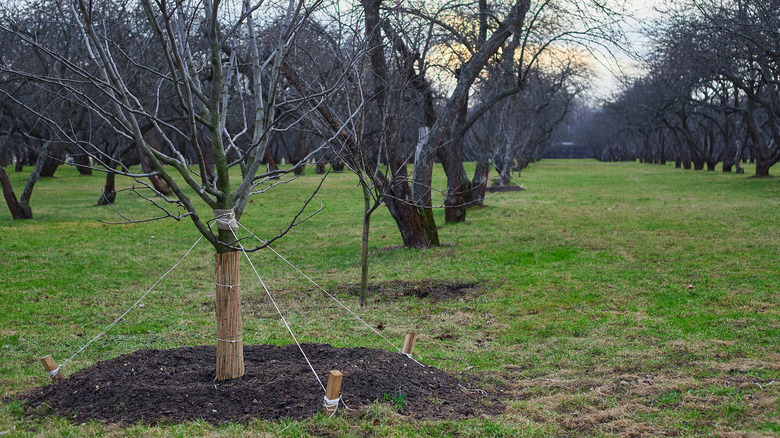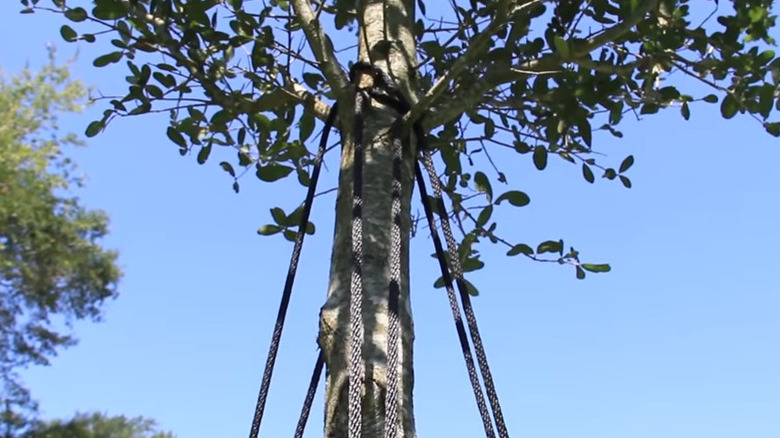TheMillennialGardener / YouTube
Properly maintaining the trees right in your yard is a crucial way to contribute to global environmental protection efforts, since trees help process carbon dioxide and release oxygen into the atmosphere while also providing habitats for important species. In many cases, homeowners inherit large, established trees when they purchase a property without much guidance about how to take care of them. One helpful secret to protecting your trees is providing stability when needed, and medium or large trees often benefit from a gardening technique called guying.
Guying is similar to staking, but the two strategies each leverage separate methods and have different ideal uses. Staking is a common practice used to stabilize very young trees that have recently been transplanted. On the other hand, gardeners generally use guying to stabilize mature, larger trees that may have been recently transplanted or that have sustained heavy winds. Staking a sapling involves using stakes that rise 3 to 5 feet above the ground. These are installed parallel to the tree trunk and attached with cable or wire. Instead of stakes, guying uses anchors that only poke out of the ground by a few inches. A wire connects the tree to each anchor and provides tension that creates vertical support. It’s important to know when you should guy a tree and the proper procedure for doing so.
When is guying necessary?

For the best outcomes in your gardening and landscaping efforts, it’s crucial to understand when to step in and provide support for one of your trees. Leaning and exposed roots due to wind damage are the largest indicators that staking or guying will be necessary. Guying can also be used to provide extra support immediately after planting trees in your yard. Selecting whether to use guying or staking comes down to the size of the tree. Generally, if a trunk is 4 inches in diameter or thicker, guying is a better solution than staking.
While transplanted trees are generally small and will require staking, in some cases more mature trees are moved, calling for guying. The other most common use for the guying technique is to support trees in a very windy environment or to restore trees that have been thrown out of place by severe winds. In these cases, a gardener will be able to see where the roots are pushing up through the soil and the trunk will be leaning. If the trunk is leaning but the roots aren’t pushing through the soil, unfortunately the trunk has most likely broken underground and the tree probably won’t survive.
How to guy a tree

treesforenergyconservation3349 / YouTube
Guying a tree requires a specific set of materials, including three metal guying anchors or 3-inch by 3-inch by 24-inch wooden stakes. You’ll also need three wires to attach the tree to the anchors, as well as burlap, canvas, or rubber strapping to attach the wires to the tree. It also helps to have a mallet or other driving device to get the anchors into place.
In order to add stability without causing any unintended damage, begin by placing the three anchors evenly spaced around the tree, pushing them deep into the ground. If you are guying in order to straighten a tree after wind damage or to protect it from future strong winds, ensure that one of the anchors is placed directly upwind. Position all the anchors within the mulched area surrounding the trunk and mark them carefully to prevent a tripping hazard.
Place the canvas or other attachment material on the tree, just above the lowest set of branches. Do this loosely in order to help the tree develop flexibility and strength — you don’t want the straps to be too tight. Further, ensure that the wires of the guying system never come into contact with the tree, as this could cause damage. Finally, connect the wires to the anchors. After one growing season, the roots should be strong enough to hold the tree and you can remove the guying system.



